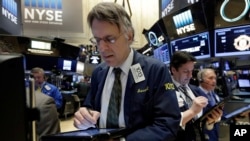U.S. equities stabilized a bit Friday, following a two-day selloff on concerns of an interest rate hike in June. The bounce was led by healthcare, financial and tech shares. Despite the late week rally, the major averages were on pace to end their fourth consecutive weekly loss.
The Federal Open Market Committee (FOMC) minutes released on Wednesday afternoon indicated that the Federal Reserve may indeed act on rates at the June meeting if data supports the move. June rate hike expectations jumped to 28% from 4% after the FOMC minutes, triggering a wave of buying and selling various sectors. Expectations now sit at 30%. But was the selling really that bad for equities?
“Markets digested the news pretty well. It was more sector rotation than a big contracted selloff,” Mark Sebastian, COO of Option Pit said. “The S&P 500 really has not gone anywhere since May and most of the action has been in the bond market.”
In the commodity complex, crude oil gained for the second week due to trouble in Nigeria crude oil terminals and outages in Canada, while gold saw its biggest weekly slide in almost two months as expectations for a rate hike grow and a stronger U.S. dollar.
Trading week ahead
In the absence of a busy earnings calendar, traders really only have macro events and data to focus on, and that will be the case until about mid-July. Two very important events are taking place in that time that will impact all asset classes, particularly global currency.
Markets will continue to be sensitive to speculation around the FOMC meeting in June and a hike in interest rates. New York Federal Reserve President William Dudley said on Thursday that there is a strong sense among Fed officials that markets were underestimating their rate hike plans and June is a “live” meeting.
“The Fed does not have to hike rates in June to save face if it remains data dependent,” Sebastian said. “We still have to get through the all-important Non-Farms Payoll employment data on June 3 and dig beneath the headline number for more clues on inflation.”
More volatility can be expected around the Brexit vote on June 23 on whether the United Kingdom should leave the European Union or not. According to the latest Financial Times poll, 47% of participants expect that the UK will stay in the European Union, while 41% believe they will leave.
Obvious concerns are being voiced on the impact to the UK economy. Supporters argue that EU countries have an incentive to stay because the UK is a large importer of goods and services, while dissenters say companies would be less likely to invest in just a single market and new trade agreements would have be drawn up with the EU. Even more pressing, if the UK were to leave the EU, would other countries follow suit and could the Union unravel?
Earnings
A handful of actively traded S&P 500 companies are slated to report including Tiffany, Costco, AutoZone, Best Buy, Abercrombie & Fitch, Dollar General, Dollar Tree and Ulta Salon.
Data to watch
New Home Sales will be in focus following very strong earnings reports from home improvement retailers Home Depot and Lowe’s. This set of data is a gauge for the demand of housing, as well as economic momentum. If the report is strong, it could imply demand for furniture, appliances and other housing goods will be higher. The Existing Home Sales report last Friday was quite strong, with an improvement in first-time home buyers and prices.
International Trade in Goods, Durable Goods Orders, and Crude and Natural Gas Inventories will also be in focus.
GDP is the all-inclusive measure of economic activity. There are four major categories: personal consumption expenditures, investment, net exports and government. It helps the Federal Reserve and investors gauge the strength or weakness in consumer spending, business and residential investment, and inflation. Unemployment data and GDP are major factors the Fed considers when creating monetary policy.





